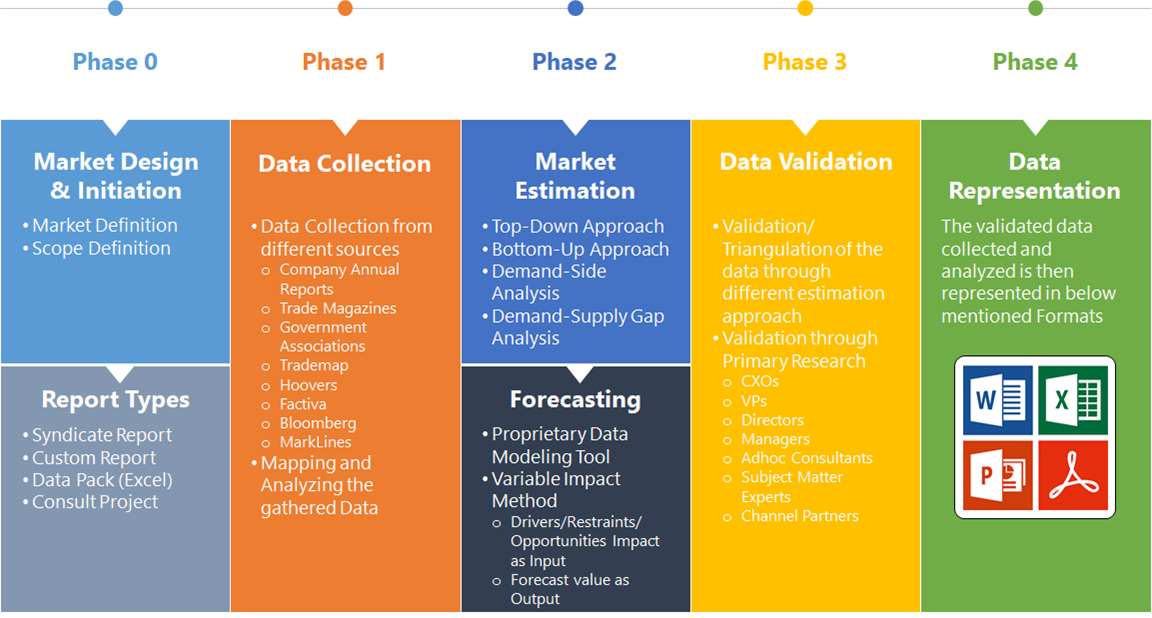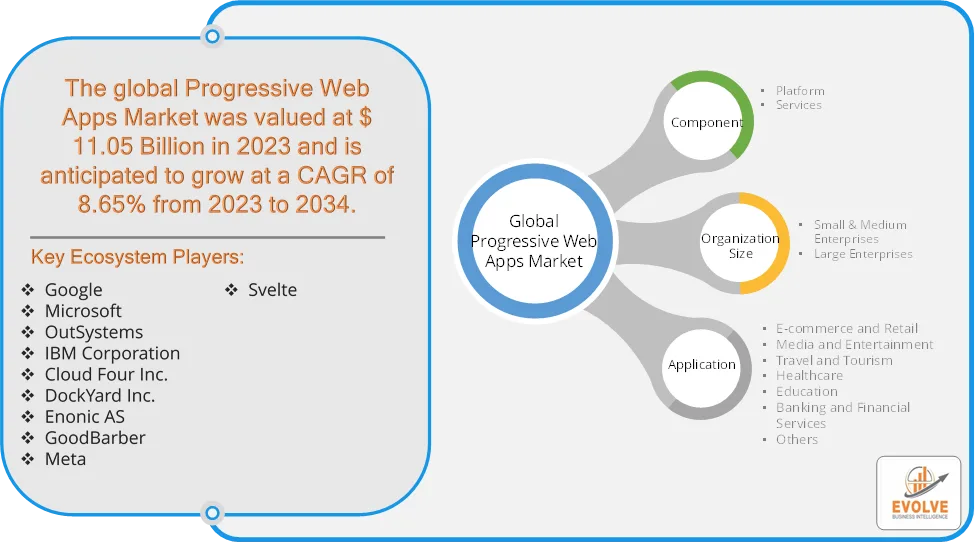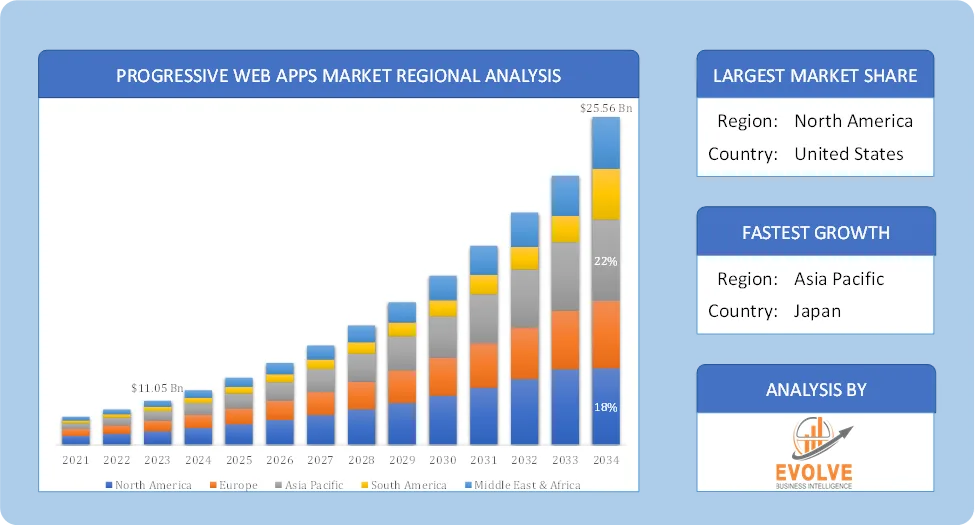Progressive Web Apps Market Analysis and Global Forecast 2024-2034
$ 1,390.00 – $ 5,520.00Price range: $ 1,390.00 through $ 5,520.00
Progressive Web Apps Market Research Report: Information By Component (Platform, Services), By Organization Size (Small & Medium Enterprises, Large Enterprises), By Applications (E-commerce and Retail, Media and Entertainment, Travel and Tourism, Healthcare, Education, Banking and Financial Services, Others), and by Region — Forecast till 2034
Page: 165
Progressive Web Apps Market Overview
The Progressive Web Apps Market size accounted for USD 11.05 Billion in 2023 and is estimated to account for 12.54 Billion in 2024. The Market is expected to reach USD 25.56 Billion by 2034 growing at a compound annual growth rate (CAGR) of 8.65% from 2024 to 2034. The Progressive Web Apps (PWA) market is experiencing substantial growth and is projected to continue on this trajectory in the coming years. PWAs are web applications that offer an app-like experience to users, combining the best of web and native applications. They are designed to be reliable, fast, and engaging, working on any device with a modern browser without requiring users to download them from an app store.
The Progressive Web Apps market is poised for strong growth, driven by the increasing demand for seamless and engaging mobile web experiences. The technology offers numerous benefits for both businesses and users, leading to its wider adoption across various industries and regions.
Global Progressive Web Apps Market Synopsis
 Progressive Web Apps Market Dynamics
Progressive Web Apps Market Dynamics
The major factors that have impacted the growth of Progressive Web Apps Market are as follows:
Drivers:
Ø Growing Smartphone & Internet Penetration
Increasing global internet usage and smartphone adoption boost the demand for PWAs. PWAs provide a seamless app-like experience across devices, making them ideal for emerging markets with diverse device ecosystems. Online shopping platforms increasingly use PWAs to enhance user experience, reduce bounce rates, and improve conversion rates. Businesses prefer cross-platform apps that work seamlessly on desktops, tablets, and smartphones. PWAs reduce dependency on app stores, allowing direct web-based distribution and PWAs consume less storage and bandwidth compared to native apps.
Restraint:
- Platform & App Store Resistance and Security Concerns
Major app store providers like Apple and Google rely on revenue from native app stores (App Store & Google Play). PWAs bypass app stores, leading to potential resistance from these platforms, including policy changes or feature limitations. PWAs rely on HTTPS for security, but some businesses worry about vulnerabilities like man-in-the-middle attacks and cross-site scripting (XSS) and Native apps benefit from app store security reviews, which add an extra layer of trust for users.
Opportunity:
⮚ Increasing Adoption by SMEs & Startups
Small and medium enterprises (SMEs) prefer PWAs due to their cost-effectiveness and ease of deployment. Online retailers are increasingly adopting PWAs to enhance user experience, improve page load speeds, and boost conversions. Companies like Alibaba, Flipkart, and Starbucks have successfully implemented PWAs, leading to higher engagement and revenue. Google, Microsoft, and Twitter actively promote PWAs by providing developer tools and browser support and Microsoft’s Edge browser and Google Chrome offer better integration for PWAs, enhancing functionality. Improvements in WebAssembly, Service Workers, and Web Push APIs are enhancing PWA performance, making them more competitive with native apps.
Progressive Web Apps Market Segment Overview
Based on Component, the market is segmented based on Platform and Services. The platform segment dominant the market. PWAs offer a key advantage, which is compatibility across all devices with a browser. This cross-device functionality enhances user satisfaction by providing a consistent and engaging experience on desktops, mobile devices, and tablets.
By Organization Size
Based on Organization Size, the market segment has been divided into Small & Medium Enterprises, Large Enterprises. The Large Enterprises segment dominant the market. Large enterprises are increasingly adopting PWAs to leverage their capabilities for delivering fast, reliable, and engaging user experiences across various devices and platforms. The significant investment capabilities of large organizations enable them to integrate advanced PWA features such as offline functionality, push notifications, and seamless performance, which are essential for maintaining competitive advantage in the digital marketplace.
By Application
Based on Application, the market segment has been divided into E-commerce and Retail, Media and Entertainment, Travel and Tourism, Healthcare, Education, Banking and Financial Services, Others. The E-commerce and Retail segment dominant the market. The e-commerce and retail sectors are rapidly adopting PWAs to improve user experience, boost conversions, and increase customer engagement. Key features like push notifications, offline access, and accelerated loading times are helping businesses achieve remarkable growth.
Global Progressive Web Apps Market Regional Analysis
Based on region, the global Progressive Web Apps Market has been divided into North America, Europe, Asia-Pacific, the Middle East & Africa, and Latin America. North America is projected to dominate the use of the Progressive Web Apps Market followed by the Asia-Pacific and Europe regions.
 North America Progressive Web Apps Market
North America Progressive Web Apps Market
North America holds a dominant position in the Progressive Web Apps Market. It has high concentration of technology firms and early adoption of digital innovations, particularly in e-commerce, media, and finance. Advanced IT infrastructure and a strong emphasis on user experience (UX) optimization and Increasing focus of large enterprises on mobile-first strategies and digital transformation.
Asia-Pacific Progressive Web Apps Market
The Asia-Pacific region has indeed emerged as the fastest-growing market for the Progressive Web Apps Market industry. Rapidly increasing internet and smartphone penetration, especially in developing economies like India and China. Cost-effectiveness and offline capabilities of PWAs, making them suitable for regions with inconsistent internet access and has strong presence of e-commerce and social media platforms driving PWA adoption for enhanced user engagement.
Competitive Landscape
The global Progressive Web Apps Market is highly competitive, with numerous players offering a wide range of software solutions. The competitive landscape is characterized by the presence of established companies, as well as emerging startups and niche players. To increase their market position and attract a wide consumer base, the businesses are employing various strategies, such as product launches, and strategic alliances.
Prominent Players:
- Microsoft
- OutSystems
- IBM Corporation
- Cloud Four Inc.
- DockYard Inc.
- Enonic AS
- GoodBarber
- Meta
Key Development
In March 202, OutSystems, a key player in high-performance low-code application development, launched AI Agent Builder, an innovative solution within the OutSystems Developer Cloud platform. This new tool simplifies the integration of generative AI (GenAI) applications into digital transformation strategies for IT leaders.
Scope of the Report
Global Progressive Web Apps Market, by Component
- Platform
- Services
Global Progressive Web Apps Market, by Organization Size
- Small & Medium Enterprises
- Large Enterprises
Global Progressive Web Apps Market, by Applications
- E-commerce and Retail
- Media and Entertainment
- Travel and Tourism
- Healthcare
- Education
- Banking and Financial Services
- Others
Global Progressive Web Apps Market, by Region
- North America
- US
- Canada
- Mexico
- Europe
- UK
- Germany
- France
- Italy
- Spain
- Benelux
- Nordic
- Rest of Europe
- Asia Pacific
- China
- Japan
- South Korea
- Indonesia
- Austalia
- Malaysia
- India
- Rest of Asia Pacific
- South America
- Brazil
- Argentina
- Rest of South America
- Middle East & Africa
- Saudi Arabia
- UAE
- Egypt
- South Africa
- Rest of Middle East & Africa
| Parameters | Indicators |
|---|---|
| Market Size | 2034: USD 25.56 Billion |
| CAGR (2024-2034) | 8.65% |
| Base year | 2022 |
| Forecast Period | 2024-2034 |
| Historical Data | 2021 (2017 to 2020 On Demand) |
| Report Coverage | Revenue Forecast, Competitive Landscape, Growth Factors, and Trends |
| Key Segmentations | Component, Organization Size, Application |
| Geographies Covered | North America, Europe, Asia-Pacific, South America, Middle East, Africa |
| Key Vendors | Google, Microsoft, OutSystems, IBM Corporation, Cloud Four Inc., DockYard Inc., Enonic AS, GoodBarber, Meta and Svelte. |
| Key Market Opportunities | · Increasing Adoption by SMEs & Startups
· Advancements in Web Technologies |
| Key Market Drivers | · Growing Smartphone & Internet Penetration
· Rising Demand for Cross-Platform Solutions |
REPORT CONTENT BRIEF:
- High-level analysis of the current and future Progressive Web Apps Market trends and opportunities
- Detailed analysis of current market drivers, restraining factors, and opportunities in the future
- Progressive Web Apps Market historical market size for the year 2021, and forecast from 2023 to 2033
- Progressive Web Apps Market share analysis at each product level
- Competitor analysis with detailed insight into its product segment, Government & Defense strength, and strategies adopted.
- Identifies key strategies adopted including product launches and developments, mergers and acquisitions, joint ventures, collaborations, and partnerships as well as funding taken and investment done, among others.
- To identify and understand the various factors involved in the global Progressive Web Apps Market affected by the pandemic
- To provide a detailed insight into the major companies operating in the market. The profiling will include the Government & Defense health of the company’s past 2-3 years with segmental and regional revenue breakup, product offering, recent developments, SWOT analysis, and key strategies.
Frequently Asked Questions (FAQ)
What is the study period of this market?
The study period of the global Progressive Web Apps Market is 2021- 2033
What is the growth rate of the global Progressive Web Apps Market?
The global Progressive Web Apps Market is growing at a CAGR of 8.65% over the next 10 years
Which region has the highest growth rate in the market of Progressive Web Apps Market?
Asia Pacific is expected to register the highest CAGR during 2024-2034
Which region has the largest share of the global Progressive Web Apps Market?
North America holds the largest share in 2022
Who are the key players in the global Progressive Web Apps Market?
Google, Microsoft, OutSystems, IBM Corporation, Cloud Four Inc., DockYard Inc., Enonic AS, GoodBarber, Meta and Svelte. are the major companies operating in the market.
Do you offer Post Sale Support?
Yes, we offer 16 hours of analyst support to solve the queries
Do you sell particular sections of a report?
Yes, we provide regional as well as country-level reports. Other than this we also provide a sectional report. Please get in contact with our sales representatives.
Press Release

Global Pharmaceutical Manufacturing Market to Reach $1.38 Trillion by 2035 with 7.35% CAGR, New Research Shows

The Global Mammography Market Is Estimated To Record a CAGR of Around 10.29% During The Forecast Period

Glue Stick Market to Reach USD 2.35 Billion by 2034

Podiatry Service Market to Reach USD 11.88 Billion by 2034

Microfluidics Technology Market to Reach USD 32.58 Billion by 2034

Ferric Chloride Market to Reach USD 10.65 Billion by 2034

Family Practice EMR Software Market to Reach USD 21.52 Billion by 2034

Electric Hairbrush Market to Reach USD 15.95 Billion by 2034

Daily Bamboo Products Market to Reach USD 143.52 Billion by 2034

Cross-border E-commerce Logistics Market to Reach USD 112.65 Billion by 2034
Table of Content
CHAPTER 1. Executive Summary
CHAPTER 2. Scope of the Study
2.1. Market Definition
2.2. Market Scope & Segmentation
2.2.1. Objective of Report
CHAPTER 3. Evolve BI Methodology
3.1. Data Collection & Validation Approach
3.2. Market Size Estimation and Forecast
CHAPTER 4. Exclusive Analysis
4.1. Market Opportunity Score
4.1.1. Component Segement – Market Opportunity Score
4.1.2. Enterprise Size Segment – Market Opportunity Score
4.1.3. End Use Segment – Market Opportunity Score
4.2. Key Market Influencing Indicators
CHAPTER 5. Market Insights and Trends
5.1. Value Chain Analysis
5.1.1. Raw Material
5.1.2. Manufacturing Process
5.1.3. Distribution Channel
5.1.4. End User
5.2. Porter’s Five Forces Analysis
5.2.1. Bargaining Power of Buyers
5.2.2. Bargaining Power of Suppliers
5.2.3. Threat of New Entrant
5.2.4. Threat of Substitute
5.2.5. Industry Rivalry
5.3. COVID-19 Impact and Post COVID Scenario on Progressive Web Apps Market
5.3.1. Impact of COVID-19
5.3.2. Government Support and Industry Revival Policies
5.3.3. Measures Taken by Companies to Mitigate Negative Impact
5.3.4. Post COVID Trend
CHAPTER 6. Market Dynamics
6.1. Introduction
6.2. Drivers
6.2.1. Driver 1
6.2.2. Driver 2
6.2.3. Driver 3
6.3. Restraints
6.3.1. Restraint 1
6.3.2. Restraint 2
6.4. Opportunity
6.4.1. Opportunity 1
CHAPTER 7. Progressive Web Apps Market, By Component
7.1. Introduction
7.1.1. Platform
7.1.2 Services
CHAPTER 8 Progressive Web Apps Market, By Organization Size
8.1. Introduction
8.1.1. Small & Medium Enterprises
8.1.2. Large Enterprises
CHAPTER 9. Progressive Web Apps Market, By Application
9.1. Introduction
9.1.1. E-commerce and Retail
9.1.2. Media and Entertainment
9.1.3. Travel and Tourism
9.1.4. Healthcare
9.1.5. Education
9.1.6. Banking and Financial Services
9.1.7. Others
CHAPTER 10. Progressive Web Apps Market, By Region
10.1. Introduction
10.2. NORTH AMERICA
10.2.1. North America: Market Size and Forecast, By Country, 2024 – 2034($ Million)
10.2.2. North America: Market Size and Forecast, By Component, 2024 – 2034($ Million)
10.2.3. North America: Market Size and Forecast, By Organization Size, 2024 – 2034($ Million)
10.2.4. North America: Market Size and Forecast, By Application, 2024 – 2034($ Million)
10.2.5. US
10.2.5.1. US: Market Size and Forecast, By Component, 2024 – 2034($ Million)
10.2.5.2. US: Market Size and Forecast, By Organization Size, 2024 – 2034($ Million)
10.2.5.3. US: Market Size and Forecast, By Application, 2024 – 2034($ Million)
10.2.6. CANADA
10.2.6.1. Canada: Market Size and Forecast, By Component, 2024 – 2034($ Million)
10.2.6.2. Canada: Market Size and Forecast, By Organization Size, 2024 – 2034($ Million)
10.2.6.3. Canada: Market Size and Forecast, By Application, 2024 – 2034($ Million)
10.2.7. MEXICO
10.2.7.1. Mexico: Market Size and Forecast, By Component, 2024 – 2034($ Million)
10.2.7.2. Mexico: Market Size and Forecast, By Organization Size, 2024 – 2034($ Million)
10.2.7.3. Mexico: Market Size and Forecast, By Application, 2024 – 2034($ Million)
10.3. Europe
10.3.1. Europe: Market Size and Forecast, By Country, 2024 – 2034($ Million)
10.3.2. Europe: Market Size and Forecast, By Component, 2024 – 2034($ Million)
10.3.3. Europe: Market Size and Forecast, By Organization Size, 2024 – 2034($ Million)
10.3.4. Europe: Market Size and Forecast, By Application, 2024 – 2034($ Million)
10.3.5. U.K.
10.3.5.1. U.K.: Market Size and Forecast, By Component, 2024 – 2034($ Million)
10.3.5.2. U.K.: Market Size and Forecast, By Organization Size, 2024 – 2034($ Million)
10.3.5.3. U.K.: Market Size and Forecast, By Application, 2024 – 2034($ Million)
10.3.6. GERMANY
10.3.6.1. Germany: Market Size and Forecast, By Component, 2024 – 2034($ Million)
10.3.6.2. Germany: Market Size and Forecast, By Organization Size, 2024 – 2034($ Million)
10.3.6.3. Germany: Market Size and Forecast, By Application, 2024 – 2034($ Million)
10.3.7. FRANCE
10.3.7.1. France: Market Size and Forecast, By Component, 2024 – 2034($ Million)
10.3.7.2. France: Market Size and Forecast, By Organization Size, 2024 – 2034($ Million)
10.3.7.3. France: Market Size and Forecast, By Application, 2024 – 2034($ Million)
10.3.8. ITALY
10.3.8.1. Italy: Market Size and Forecast, By Component, 2024 – 2034($ Million)
10.3.8.2. Italy: Market Size and Forecast, By Organization Size, 2024 – 2034($ Million)
10.3.8.3. Italy: Market Size and Forecast, By Application, 2024 – 2034($ Million)
10.3.9. SPAIN
10.3.9.1. Spain: Market Size and Forecast, By Component, 2024 – 2034($ Million)
10.3.9.2. Spain: Market Size and Forecast, By Organization Size, 2024 – 2034($ Million)
10.3.9.3. Spain: Market Size and Forecast, By Application, 2024 – 2034($ Million)
10.3.10. BENELUX
10.3.10.1. BeNeLux: Market Size and Forecast, By Component, 2024 – 2034($ Million)
10.3.10.2. BeNeLux: Market Size and Forecast, By Organization Size, 2024 – 2034($ Million)
10.3.10.3. BeNeLux: Market Size and Forecast, By Application, 2024 – 2034($ Million)
10.3.11. RUSSIA
10.3.11.1. Russia: Market Size and Forecast, By Component, 2024 – 2034($ Million)
10.3.11.2. Russia: Market Size and Forecast, By Organization Size, 2024 – 2034($ Million)
10.3.11.3. Russia: Market Size and Forecast, By Application, 2024 – 2034($ Million)
10.3.12. REST OF EUROPE
10.3.12.1. Rest of Europe: Market Size and Forecast, By Component, 2024 – 2034($ Million)
10.3.12.2. Rest of Europe: Market Size and Forecast, By Source, 2024 – 2034($ Million)
10.3.12.3. Rest of Europe: Market Size and Forecast, By Application, 2024 – 2034($ Million)
10.4. Asia Pacific
10.4.1. Asia Pacific: Market Size and Forecast, By Country, 2024 – 2034($ Million)
10.4.2. Asia Pacific: Market Size and Forecast, By Component, 2024 – 2034($ Million)
10.4.3. Asia Pacific: Market Size and Forecast, By Organization Size, 2024 – 2034($ Million)
10.4.4. Asia Pacific: Market Size and Forecast, By Application, 2024 – 2034($ Million)
10.4.5. CHINA
10.4.5.1. China: Market Size and Forecast, By Component, 2024 – 2034($ Million)
10.4.5.2. China: Market Size and Forecast, By Organization Size, 2024 – 2034($ Million)
10.4.5.3. China: Market Size and Forecast, By Application, 2024 – 2034($ Million)
10.4.6. JAPAN
10.4.6.1. Japan: Market Size and Forecast, By Component, 2024 – 2034($ Million)
10.4.6.2. Japan: Market Size and Forecast, By Organization Size, 2024 – 2034($ Million)
10.4.6.3. Japan: Market Size and Forecast, By Application, 2024 – 2034($ Million)
10.4.7. INDIA
10.4.7.1. India: Market Size and Forecast, By Component, 2024 – 2034($ Million)
10.4.7.2. India: Market Size and Forecast, By Organization Size, 2024 – 2034($ Million)
10.4.7.3. India: Market Size and Forecast, By Application, 2024 – 2034($ Million)
10.4.8. SOUTH KOREA
10.4.8.1. South Korea: Market Size and Forecast, By Component, 2024 – 2034($ Million)
10.4.8.2. South Korea: Market Size and Forecast, By Organization Size, 2024 – 2034($ Million)
10.4.8.3. South Korea: Market Size and Forecast, By Application, 2024 – 2034($ Million)
10.4.9. THAILAND
10.4.9.1. Thailand: Market Size and Forecast, By Component, 2024 – 2034($ Million)
10.4.9.2. Thailand: Market Size and Forecast, By Organization Size, 2024 – 2034($ Million)
10.4.9.3. Thailand: Market Size and Forecast, By Application, 2024 – 2034($ Million)
10.4.10. INDONESIA
10.4.10.1. Indonesia: Market Size and Forecast, By Component, 2024 – 2034($ Million)
10.4.10.2. Indonesia: Market Size and Forecast, By Organization Size, 2024 – 2034($ Million)
10.4.10.3. Indonesia: Market Size and Forecast, By Application, 2024 – 2034($ Million)
10.4.11. MALAYSIA
10.4.11.1. Malaysia: Market Size and Forecast, By Component, 2024 – 2034($ Million)
10.4.11.2. Malaysia: Market Size and Forecast, By Organization Size, 2024 – 2034($ Million)
10.4.11.3. Malaysia: Market Size and Forecast, By Application, 2024 – 2034($ Million)
10.4.12. AUSTRALIA
10.4.12.1. Australia: Market Size and Forecast, By Component, 2024 – 2034($ Million)
10.4.12.2. Australia: Market Size and Forecast, By Organization Size, 2024 – 2034($ Million)
10.4.12.3. Australia: Market Size and Forecast, By Application, 2024 – 2034($ Million)
10.4.13. REST FO ASIA PACIFIC
10.4.13.1. Rest fo Asia Pacific: Market Size and Forecast, By Component, 2024 – 2034($ Million)
10.4.13.2. Rest fo Asia Pacific: Market Size and Forecast, By Organization Size, 2024 – 2034($ Million)
10.4.13.3. Rest fo Asia Pacific: Market Size and Forecast, By Application, 2024 – 2034($ Million)
10.5. South America
10.5.1. South America: Market Size and Forecast, By Country, 2024 – 2034($ Million)
10.5.2. South America: Market Size and Forecast, By Component, 2024 – 2034($ Million)
10.5.3. South America: Market Size and Forecast, By System, 2024 – 2034($ Million)
10.5.4. South America: Market Size and Forecast, By Application, 2024 – 2034($ Million)
10.5.5. BRAZIL
10.5.5.1. Brazil: Market Size and Forecast, By Component, 2024 – 2034($ Million)
10.5.5.2. Brazil: Market Size and Forecast, By Organization Size, 2024 – 2034($ Million)
10.5.5.3. Brazil: Market Size and Forecast, By Application, 2024 – 2034($ Million)
10.5.6. ARGENTINA
10.5.6.1. Argentina: Market Size and Forecast, By Component, 2024 – 2034($ Million)
10.5.6.2. Argentina: Market Size and Forecast, By Organization Size, 2024 – 2034($ Million)
10.5.6.3. Argentina: Market Size and Forecast, By Application, 2024 – 2034($ Million)
10.5.7. REST OF SOUTH AMERICA
10.5.7.1. Rest of South America: Market Size and Forecast, By Component, 2024 – 2034($ Million)
10.5.7.2. Rest of South America: Market Size and Forecast, By Organization Size, 2024 – 2034($ Million)
10.5.7.3. Rest of South America: Market Size and Forecast, By Application, 2024 – 2034($ Million)
10.6. Middle East & Africa
10.6.1. Middle East & Africa: Market Size and Forecast, By Country, 2024 – 2034($ Million)
10.6.2. Middle East & Africa: Market Size and Forecast, By Component, 2024 – 2034($ Million)
10.6.3. Middle East & Africa: Market Size and Forecast, By Organization Size, 2024 – 2034($ Million)
10.6.4. Middle East & Africa: Market Size and Forecast, By Application, 2024 – 2034($ Million)
10.6.5. SAUDI ARABIA
10.6.5.1. Saudi Arabia: Market Size and Forecast, By Component, 2024 – 2034($ Million)
10.6.5.2. Saudi Arabia: Market Size and Forecast, By Organization Size, 2024 – 2034($ Million)
10.6.5.3. Saudi Arabia: Market Size and Forecast, By Application, 2024 – 2034($ Million)
10.6.6. UAE
10.6.6.1. UAE: Market Size and Forecast, By Component, 2024 – 2034($ Million)
10.6.6.2. UAE: Market Size and Forecast, By Organization Size, 2024 – 2034($ Million)
10.6.6.3. UAE: Market Size and Forecast, By Application, 2024 – 2034($ Million)
10.6.7. EGYPT
10.6.7.1. Egypt: Market Size and Forecast, By Component, 2024 – 2034($ Million)
10.6.7.2. Egypt: Market Size and Forecast, By Organization Size, 2024 – 2034($ Million)
10.6.7.3. Egypt: Market Size and Forecast, By Application, 2024 – 2034($ Million)
10.6.8. SOUTH AFRICA
10.6.8.1. South Africa: Market Size and Forecast, By Component, 2024 – 2034($ Million)
10.6.8.2. South Africa: Market Size and Forecast, By Organization Size, 2024 – 2034($ Million)
10.6.8.3. South Africa: Market Size and Forecast, By Application, 2024 – 2034($ Million)
10.6.9. REST OF MIDDLE EAST & AFRICA
10.6.9.1. Rest of Middle East & Africa: Market Size and Forecast, By Component, 2024 – 2034($ Million)
10.6.9.2. Rest of Middle East & Africa: Market Size and Forecast, By Organization Size, 2024 – 2034($ Million)
10.6.9.3.Rest of Middle East & Africa: Market Size and Forecast, By Application, 2024 – 2034($ Million)
CHAPTER 12. Competitive Landscape
12.1. Competitior Benchmarking 2023-
12.2. Market Share Analysis
12.3. Key Developments Analysis By Top 5 Companies
12.4. Market Share Acquisition Strategies: Analysis of Key Approaches Employed by Top Players
CHAPTER 13. Company Profiles
13.1. Google
13.1.1. Hanon Systems
13.1.2. Financial Analysis
13.1.2.1. Business Segment Revenue, 2020, 2021, 2022, $ Million
13.1.2.2. Geographic Revenue Mix, 2022 (% Share)
13.1.3. Product Portfolio
13.1.4. Recent Development and Strategies Adopted
13.1.5. SWOT Analysis
13.2. Microsoft
13.3. OutSystems
13.4. IBM Corporation.
13.5. Cloud Four Inc.
13.6. DockYard Inc.
13.7. Enonic AS
13.8. GoodBarber
13.9 Meta
13.10 Svelte.
Connect to Analyst
Research Methodology










